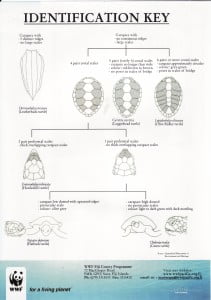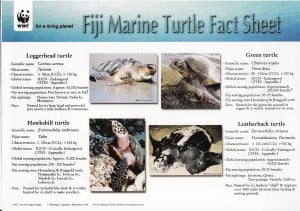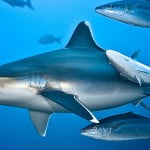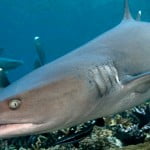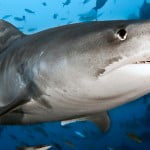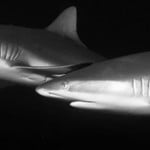The Green sea turtle (Chelonia mydas), also known as green turtle, black (sea) turtle, or Pacific green turtle,[3] is a large sea turtle of the familyCheloniidae. It is the only species in the genus Chelonia.[4] Its range extends throughout tropical and subtropical seas around the world, with two distinct populations in the Atlantic and Pacific Oceans.[5] Their common name derives from the usually green fat found beneath their carapace (upper shell).
The green sea turtle is a sea turtle, possessing a dorsoventrally flattened body covered by a large, teardrop-shaped carapace and a pair of large, paddle-likeflippers. It is usually lightly colored, although parts of the carapace can be almost black in the eastern Pacific. Unlike other members of its family, such as thehawksbill sea turtle and loggerhead sea turtle, C. mydas is mostly herbivorous. The adults commonly inhabit shallow lagoons, feeding mostly on various species of seagrasses.[6]
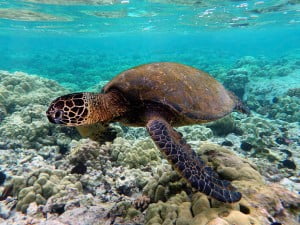 Like other sea turtles, they migrate long distances between feeding grounds and hatching beaches. Many islands worldwide are known as Turtle Island due to green sea turtles nesting on their beaches. Females crawl out on beaches, dig nests and lay eggs during the night. Later, hatchlings emerge and walk into the water. Those that reach maturity may live to age 80 in the wild.[5]
Like other sea turtles, they migrate long distances between feeding grounds and hatching beaches. Many islands worldwide are known as Turtle Island due to green sea turtles nesting on their beaches. Females crawl out on beaches, dig nests and lay eggs during the night. Later, hatchlings emerge and walk into the water. Those that reach maturity may live to age 80 in the wild.[5]
C. mydas is listed as endangered by the IUCN and CITES and is protected from exploitation in most countries. It is illegal to collect, harm or kill them. In addition, many countries have laws and ordinances to protect nesting areas. However, turtles are still in danger because of several human practices. In some countries, turtles and their eggs are hunted for food. Pollution indirectly harms turtles at both population and individual scales. Many turtles die caught in fishing nets. Also, real estate development often causes habitat loss by eliminating nesting beaches.
Ecology and behavior

As one of the first sea turtle species studied, much of what is known of sea turtle ecology comes from studies of green turtles. The ecology of C. mydaschanges drastically with each stage of its life history. Newly emerged hatchlings are carnivorous, pelagic organisms, part of the open ocean mininekton. In contrast, immature juveniles and adults are commonly found in seagrass meadows closer inshore as herbivorous grazers.
Habitat
Green sea turtles move across three habitat types, depending on their life stage. They lay eggs on beaches. Mature turtles spend most of their time in shallow, coastal waters with lush seagrass beds. Adults frequent inshore bays, lagoons and shoals with lush seagrass meadows. Entire generations often migrate between one pair of feeding and nesting areas.[16]
Turtles spend most of their first five years in convergence zones within the open ocean.[6][39] These young turtles are rarely seen as they swim in deep,pelagic waters.[40][41]
Green sea turtles typically swim at 2.5-3kph (0.7-0.8 m/s).[42]
Predators
Only human beings and the larger sharks feed on C. mydas adults. Specifically, tiger sharks (Galeocerdo cuvier) hunt adults in Hawaiian waters.[43] Juveniles and new hatchlings have significantly more predators, including crabs, small marine mammals and shorebirds.[5] In Turkey, their eggs are vulnerable to predation by red foxes and golden jackals.[44]
Life cycle
Green sea turtles migrate long distances between feeding sites and nesting sites; some swim more than 2,600 kilometres (1,600 mi) to reach their spawning grounds. Mature turtles often return to the exact beach from which they hatched. Females usually mate every two to four years. Males, on the other hand, visit the breeding areas every year, attempting to mate.[45] Mating seasons vary between populations. For most C. mydas in the Caribbean, mating season is from June to September.[16] The French Guiana nesting subpopulation nests from March to June.[23] In the tropics, green turtles nest throughout the year, although some subpopulations prefer particular times of the year. In Pakistan, Indian Ocean turtles nest year-round, but prefer the months of July to December.[36]
Green sea turtles mating is similar to other marine turtles. Female turtles control the process. A few populations practice polyandry, although this does not seem to benefit hatchlings.[46] After mating in the water, the female moves above the beach’s high tide line, where she digs a hole with her hind flippers and deposits her eggs. Clutch size depends on the age of the female and species, but can range between 100 and 200. She then covers the nest with sand and returns to the sea.[5]
At around 45 to 75 days, the eggs hatch during the night, and the hatchlings instinctively head directly into the water. This is the most dangerous time in a turtle’s life. As they walk, predators, such as gulls and crabs, feed on them. A significant percentage never make it to the ocean. Little is known of the initial life history of newly hatched sea turtles.[16] Juveniles spend three to five years in the open ocean before they settle as still-immature juveniles into their permanent shallow-water lifestyle.[40][41] It is speculated that they take twenty to fifty years to reach sexual maturity. Individuals live up to eighty years in the wild.[5]
Each year on Ascension Island in the South Atlantic, C. mydas females create 6,000 to 15,000 nests. They are among the largest green turtles in the world; many are more than a metre in length and weigh up to 300 kilograms (660 lb).[47]
Breathing and sleep
Sea turtles spend almost all their lives submerged, but must breathe air for the oxygen needed to meet the demands of vigorous activity. With a single explosive exhalation and rapid inhalation, sea turtles can quickly replace the air in their lungs. The lungs permit a rapid exchange of oxygen and prevent gases from being trapped during deep dives. Sea turtle blood can deliver oxygen efficiently to body tissues even at the pressures encountered during diving. During routine activity, green and loggerhead turtles dive for about four to five minutes, and surface to breathe for one to three seconds.
Turtles can rest or sleep underwater for several hours at a time, but submergence time is much shorter while diving for food or to escape predators. Breath-holding ability is affected by activity and stress, which is why turtles quickly drown in shrimp trawlers and other fishing gear.


